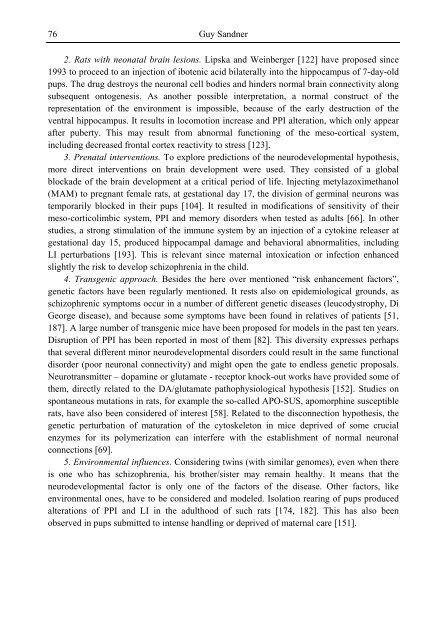Schizophrenia Research Trends
Schizophrenia Research Trends
Schizophrenia Research Trends
- No tags were found...
You also want an ePaper? Increase the reach of your titles
YUMPU automatically turns print PDFs into web optimized ePapers that Google loves.
76Guy Sandner2. Rats with neonatal brain lesions. Lipska and Weinberger [122] have proposed since1993 to proceed to an injection of ibotenic acid bilaterally into the hippocampus of 7-day-oldpups. The drug destroys the neuronal cell bodies and hinders normal brain connectivity alongsubsequent ontogenesis. As another possible interpretation, a normal construct of therepresentation of the environment is impossible, because of the early destruction of theventral hippocampus. It results in locomotion increase and PPI alteration, which only appearafter puberty. This may result from abnormal functioning of the meso-cortical system,including decreased frontal cortex reactivity to stress [123].3. Prenatal interventions. To explore predictions of the neurodevelopmental hypothesis,more direct interventions on brain development were used. They consisted of a globalblockade of the brain development at a critical period of life. Injecting metylazoximethanol(MAM) to pregnant female rats, at gestational day 17, the division of germinal neurons wastemporarily blocked in their pups [104]. It resulted in modifications of sensitivity of theirmeso-corticolimbic system, PPI and memory disorders when tested as adults [66]. In otherstudies, a strong stimulation of the immune system by an injection of a cytokine releaser atgestational day 15, produced hippocampal damage and behavioral abnormalities, includingLI perturbations [193]. This is relevant since maternal intoxication or infection enhancedslightly the risk to develop schizophrenia in the child.4. Transgenic approach. Besides the here over mentioned “risk enhancement factors”,genetic factors have been regularly mentioned. It rests also on epidemiological grounds, asschizophrenic symptoms occur in a number of different genetic diseases (leucodystrophy, DiGeorge disease), and because some symptoms have been found in relatives of patients [51,187]. A large number of transgenic mice have been proposed for models in the past ten years.Disruption of PPI has been reported in most of them [82]. This diversity expresses perhapsthat several different minor neurodevelopmental disorders could result in the same functionaldisorder (poor neuronal connectivity) and might open the gate to endless genetic proposals.Neurotransmitter – dopamine or glutamate - receptor knock-out works have provided some ofthem, directly related to the DA/glutamate pathophysiological hypothesis [152]. Studies onspontaneous mutations in rats, for example the so-called APO-SUS, apomorphine susceptiblerats, have also been considered of interest [58]. Related to the disconnection hypothesis, thegenetic perturbation of maturation of the cytoskeleton in mice deprived of some crucialenzymes for its polymerization can interfere with the establishment of normal neuronalconnections [69].5. Environmental influences. Considering twins (with similar genomes), even when thereis one who has schizophrenia, his brother/sister may remain healthy. It means that theneurodevelopmental factor is only one of the factors of the disease. Other factors, likeenvironmental ones, have to be considered and modeled. Isolation rearing of pups producedalterations of PPI and LI in the adulthood of such rats [174, 182]. This has also beenobserved in pups submitted to intense handling or deprived of maternal care [151].
















